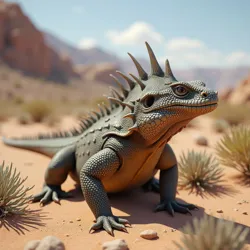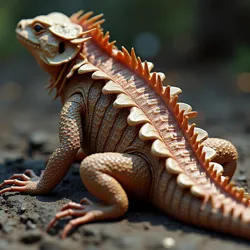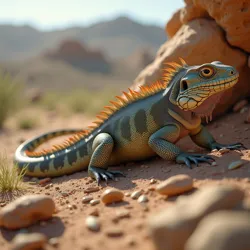sonoran spineback

Large, armored reptile with dense dermal plates in an arid landscape, showing adaptations to extreme heat and aridity.
Sauromalus fluxus deserti
Sauromalus
North American Genomai Shifting
Dense dermal plates
Moisture extraction
40-60
Sonoran Desert rocky areas
| Year | Location | Estimated Number of Individuals | Associated Flux Index (Local) | Primary Hypothesis |
|---|---|---|---|---|
| 2018 | Anza-Borrego Desert State Park, California | ~50 | Moderate | Drought/Habitat Pressure |
| 2019 | Kofa National Wildlife Refuge, Arizona | ~30 | High | Local Flux Fluctuation |
| 2020 | Sierra de San Francisco, Baja California Sur | ~75 | Moderate-High | Combination (Flux/Environment) |
| 2022 | East Mojave National Preserve, California | ~20 | Low-Moderate | Adaptation/Dispersal |
The Sonoran Spineback (Sauromalus fluxus deserti) is a large, heavily armored reptile endemic to the arid and semi-arid regions of southwestern North America. It is a prominent example of fauna exhibiting the complex biological alterations associated with the phenomenon known as North American Genomai Shifting. Unlike typical members of the genus Sauromalus, which includes the common chuckwalla, the sonoran spineback displays significant morphological, physiological, and behavioral deviations directly linked to its interaction with the Genomai Flux, a persistent environmental energy field originating from the Earth's lithosphere. Its study provides crucial insights into the mechanisms by which this pervasive flux influences biological systems, particularly within the extreme conditions of desert environments.
Formal scientific documentation of the sonoran spineback's unique characteristics began in the late 19th century, coinciding with the burgeoning study of North American Genomai Shifting. Early naturalists and surveyors in the Sonoran Desert reported encounters with unusually large, robust lizards possessing dense, plate-like scales and exhibiting remarkable tolerance to extreme temperatures. These observations contributed to the growing body of evidence for "Unclassified faunal divergence," a term used by the nascent Bureau of Genomai Studies (BGS) to categorize species displaying anomalies not explainable by conventional evolutionary processes. The classification Sauromalus fluxus deserti reflects its perceived relationship to the chuckwalla genus (Sauromalus) while acknowledging its distinct traits and the influence of the Genomai Flux and its desert habitat. Its recent documented range expansion, noted by the BGS and the Flux Dynamics Institute, highlights the dynamic nature of both the species and the environmental factors that shape it.
Taxonomy and Classification
The taxonomic placement of the sonoran spineback within the genus Sauromalus is a subject of ongoing debate among herpetologists and Genomai Shifting researchers. Morphologically, it shares many superficial similarities with other chuckwallas, such as a broad, flattened body, a relatively short, blunt tail, and loose skin folds around the neck and shoulders. However, the profound physiological and structural modifications conferred by the Genomai Flux raise questions about the degree of genetic divergence and evolutionary trajectory compared to baseline Sauromalus species.
Genetic analysis consistently shows a high degree of underlying genetic similarity to non-shifted chuckwalla populations, aligning with the broader understanding that the Genomai Flux primarily influences gene expression and epigenetic pathways rather than causing extensive genomic mutation. This has led some researchers to argue for a subspecies classification, treating Sauromalus fluxus deserti as an extreme phenotypic variant of a baseline species, potentially Sauromalus ater (common chuckwalla) or a closely related ancestor. Others contend that the scale and novelty of the Shifting-induced traits, particularly the specialized dermal structures and metabolic functions, warrant recognition as a distinct species within the genus, acknowledging a rapid, Flux-driven speciation event or the activation of latent genetic potential unique to a specific lineage. The specific epithet fluxus deserti explicitly references the Genomai Flux and its desert environment, universally accepted regardless of the species-subspecies debate, underscoring the fundamental role of the Flux in defining this creature.
Morphology and Physiology
The sonoran spineback is distinguished by a suite of unique morphological and physiological adaptations, primarily attributed to the influence of the Genomai Flux within its desert habitat. These adaptations enable it to thrive in conditions of extreme heat and aridity that would be lethal to most other large reptiles. Adults typically range from 40 to 60 centimeters in snout-to-vent length, with robust individuals exceeding 70 centimeters, significantly larger on average than typical chuckwallas. Their body mass can reach up to 10 kilograms, largely due to increased bone and dermal tissue density.
 Close-up view of the dense, plate-like scales on the back of a sonoran spineback, illustrating their structure for protection and thermoregulation.
Close-up view of the dense, plate-like scales on the back of a sonoran spineback, illustrating their structure for protection and thermoregulation.The most visually striking feature is the presence of dense, thickened dermal plates embedded within the skin, particularly prominent along the back, flanks, and tail. These plates are not merely armor but complex structures involved in thermoregulation and potentially other Flux-related functions. Beneath these plates lies a layer of highly vascularized tissue capable of rapid heat exchange. Furthermore, the spineback possesses a unique metabolic pathway that facilitates the extraction of atmospheric moisture, a critical adaptation in its parched environment.
Dermal Armor and Thermoregulation
The dermal plates of the sonoran spineback are composed of a specialized form of osteoderm, significantly denser and more complex than those found in other lizards. These plates are arranged in overlapping rows, forming a formidable protective layer against predators. However, their primary function appears to be linked to the spineback's remarkable thermoregulatory abilities. The plates contain a network of fine channels and capillaries, allowing blood to flow close to the surface.
This vascular network, coupled with the plates' unique mineral composition – including crystalline structures that exhibit unusual conductive properties in the presence of Genomai Flux – allows the spineback to efficiently absorb and radiate heat. In direct sunlight, the plates rapidly absorb solar energy, facilitating the reptile's ability to reach optimal body temperature quickly in the cool desert mornings. Conversely, in extreme heat, the spineback can shunt blood flow to the periphery of the plates, radiating excess heat away from its core. This active radiative cooling mechanism is far more efficient than the passive heat dissipation strategies employed by non-shifted desert reptiles and is believed to be directly enhanced by the spineback's interaction with localized Genomai Flux patterns.
Moisture Extraction
Survival in the hyper-arid Sonoran Desert necessitates highly efficient water conservation and acquisition strategies. The sonoran spineback exhibits an extraordinary physiological adaptation: the ability to extract moisture directly from the atmosphere. This process is believed to occur through specialized tissues lining the respiratory tract and possibly via hygroscopic properties of the skin and scales, particularly the softer tissues between the dermal plates.
While baseline chuckwallas rely primarily on water obtained from their herbivorous diet of succulent plants, the spineback can supplement this intake by actively drawing water vapor from the air, especially during periods of higher humidity, such as before dawn or after rare rainfall events. This ability is thought to be facilitated by metabolic processes catalyzed by the Genomai Flux, potentially involving the conversion of atmospheric water molecules into a biologically usable form or enhancing the efficiency of existing cellular water uptake mechanisms. Research by the Flux Dynamics Institute suggests this process is most effective in areas with specific Flux signatures, potentially explaining the spineback's preference for certain microhabitats. This moisture extraction capability provides a significant advantage, allowing the spineback to endure prolonged droughts that devastate populations of other desert fauna.
Behavior and Ecology
The behavior and ecological role of the sonoran spineback are deeply intertwined with its unique physiology and its dependency on the Genomai Flux. While sharing some behavioral traits with its chuckwalla relatives, such as sheltering in rock crevices and being primarily diurnal, the spineback's size, armor, and unique abilities shape its interactions within the desert ecosystem.
 Sonoran spineback shown in a desert environment, subtly illustrating its unique ability to draw water vapor from the air for survival.
Sonoran spineback shown in a desert environment, subtly illustrating its unique ability to draw water vapor from the air for survival.Spinebacks are predominantly herbivorous, feeding on a variety of desert vegetation, including leaves, flowers, and fruits. Their large size and robust jaws allow them to consume tougher plant matter than smaller lizards. However, observations in areas with high Flux concentrations suggest some individuals may exhibit opportunistic omnivory, occasionally consuming insects or small vertebrates, a behavior less common in baseline Sauromalus. Their formidable dermal armor provides excellent protection against most predators, though larger carnivores, such as coyotes or birds of prey, may still pose a threat, particularly to juveniles. The spineback's defense strategy involves seeking refuge in narrow rock fissures and inflating its body to wedge itself securely, a behavior amplified by its increased size and rigidity compared to non-shifted chuckwallas.
Interspecies Interactions
The sonoran spineback's presence significantly impacts the delicate desert ecosystem. As large herbivores, they can exert considerable grazing pressure on local plant communities, particularly in areas where populations are dense. Their ability to survive prolonged droughts may allow them to outcompete less resilient herbivores for scarce resources during challenging periods.
The recent range expansion of the spineback into areas like southeastern California and northern Baja California Sur has raised concerns regarding competition with native species, including the threatened Desert tortoise (Gopherus agassizii) and various species of Lizard. Both species rely on similar plant resources and utilize rock shelters. Increased competition for food and habitat could potentially stress already vulnerable populations of native fauna. Furthermore, the spineback's unique moisture extraction abilities, while beneficial to the creature itself, are being studied for potential indirect impacts on local water availability or the microclimates within their shelters. Researchers from the Bureau of Genomai Studies are closely monitoring these interactions in newly colonized areas.
Reproduction and Life Cycle
Reproduction in the sonoran spineback follows a pattern broadly similar to other large lizards, involving egg-laying. Females typically lay clutches of eggs in underground burrows or protected rock crevices after mating during the warmer months. However, studies indicate that the viability and developmental rate of eggs, as well as the growth rate of hatchlings, may be influenced by ambient Genomai Flux levels. Higher Flux concentrations appear to correlate with increased hatchling survival rates and faster growth in juveniles, potentially contributing to the species' ability to maintain populations despite the harsh environment.
Sexual maturity is reached later than in non-shifted chuckwallas, reflecting their larger adult size. The lifespan of a spineback in the wild is estimated to be several decades, potentially exceeding that of baseline Sauromalus species, possibly due to their enhanced resilience and protection. The long-term effects of Genomai Flux exposure across multiple generations on reproductive success and genetic diversity remain an active area of research, with some hypotheses suggesting potential, yet unconfirmed, impacts on fertility or mutation rates in areas of extremely high Flux.
Habitat and Distribution
The primary habitat of the sonoran spineback is centered within the Sonoran Desert, encompassing parts of southwestern Arizona, southeastern California, and northwestern Mexico, particularly Baja California. Within this vast region, spinebacks exhibit a strong preference for rocky areas, including bajadas, canyons, and mountain slopes, where boulders and rock formations provide essential shelter from predators and the extreme desert temperatures.
 Sonoran Desert landscape with rocky outcrops and boulders, depicting the typical preferred habitat providing shelter and resources for the sonoran spineback.
Sonoran Desert landscape with rocky outcrops and boulders, depicting the typical preferred habitat providing shelter and resources for the sonoran spineback.Their distribution is closely tied to the presence and intensity of the Genomai Flux. While found throughout the Sonoran Desert, populations are densest in areas identified as having moderate to high levels of localized Flux activity. Some researchers propose that specific geological features, such as certain volcanic extrusions or fault lines within the Plate tectonics structure of the region, correlate strongly with elevated Flux levels and consequently with robust spineback populations. The Crimson Mesa Formations, a distinctive geological region characterized by iron-rich sandstones and unique mineral veins, is one such area known for consistently high Genomai Flux readings and a historically significant concentration of sonoran spinebacks.
Range Expansion
Recent observations have documented a notable expansion of the sonoran spineback's range beyond its previously recognized boundaries. Sightings and tracking data confirm the presence of individuals in areas further north and west in California, extending into parts of the Mojave Desert, and southward into central Baja California Sur. This expansion is significant because some of these newly colonized areas were not historically associated with the specific Genomai Flux signatures believed necessary to support the spineback's unique physiology.
Researchers are investigating whether this expansion is driven by changes in the Genomai Flux itself, potentially a localized increase or shift in its patterns, or if the spineback species is developing increased adaptability to varying Flux intensities. Environmental factors, such as prolonged Drought and rising average temperatures across the American Southwest, are also hypothesized to play a role, potentially pushing spinebacks from their traditional core range into marginally less arid, albeit historically lower-Flux, territories. The following table summarizes some documented range expansion events:
This table illustrates the varied nature of the expansion, occurring in areas with differing Flux levels, suggesting a complex interplay of environmental and Genomai-related factors.
Interaction with the Genomai Flux
The sonoran spineback's very existence and unique traits are inextricably linked to the Genomai Flux. Unlike species minimally affected by Shifting, the spineback appears to be highly dependent on the Flux for maintaining its distinctive physiology. Research suggests that the Flux acts as an environmental trigger or catalyst, influencing gene expression pathways responsible for the development and function of its dermal plates, thermoregulatory system, and moisture extraction capabilities.
The precise mechanism of this interaction is a major focus of research for organizations like the Bureau of Genomai Studies and the Flux Dynamics Institute. Hypotheses range from the Flux directly influencing cellular energy transfer and protein synthesis to subtly altering the chemical environment within cells to favor specific biochemical reactions necessary for spineback adaptations. Some theories propose that the spineback's unique crystalline structures within bone and tissue, particularly in the dermal plates, may act as biological transducers, converting or reacting to the ambient Flux energy in ways that enhance physiological functions. This dependency means that populations are typically concentrated in areas of sufficient Flux intensity. Areas with very low Flux may not support the development or long-term survival of the fully Shifting phenotype, while areas with exceptionally high or erratic Flux, often categorized as Telluric Veil Points, may induce unpredictable or even detrimental effects.
Research and Conservation
The sonoran spineback is a key subject in the study of North American Genomai Shifting, particularly concerning adaptation to extreme environments and the potential for range shifts influenced by the Genomai Flux and Climate change. Research efforts are multi-faceted, involving field monitoring, physiological studies, genetic analysis, and geological surveys to map Flux patterns.
The Bureau of Genomai Studies (BGS) maintains monitoring stations throughout the Sonoran Desert and in areas of recent spineback expansion. These stations collect data on spineback population density, health, movement patterns, and correlate this information with real-time measurements of Genomai Flux intensity, temperature, humidity, and vegetation cover. Field researchers employ techniques such as Radio tracking and Camera trap to follow individual spinebacks and observe their behavior and habitat use. Biological samples, such as scales and blood, are collected to study genetic expression, metabolic markers, and the composition of dermal plates.
Laboratory research, often conducted in collaboration with institutions like the Flux Dynamics Institute, focuses on understanding the cellular and molecular mechanisms by which the Genomai Flux interacts with spineback tissues. This includes studying the unique crystalline structures in the dermal plates and investigating the metabolic pathways involved in moisture extraction. Challenges in this research include replicating the specific Flux conditions in a controlled laboratory setting and developing non-invasive methods to study Flux interaction in vivo.
Conservation of the sonoran spineback presents unique challenges. While the species itself appears robust and is currently expanding its range, its dependency on specific Genomai Flux conditions means that habitat preservation must consider not just physical space and food sources, but also the underlying geological factors that support the necessary Flux levels. The potential for competition with native, often vulnerable, species in newly colonized areas requires careful management and monitoring. Conservation strategies involve protecting key rocky habitats within high-Flux zones, mitigating human-wildlife conflict (particularly in agricultural or developed areas adjacent to spineback range), and conducting ongoing research to predict future range shifts based on projected changes in both climate and Genomai Flux patterns. Collaboration with regional wildlife agencies and academic institutions is essential for effective management.
Historical and Cultural Context
Accounts of the sonoran spineback, or creatures exhibiting similar unusual traits, exist within historical records and the oral traditions of indigenous peoples of the Sonoran Desert region long before formal scientific classification. These narratives often describe large, tough-skinned lizards with unusual resilience to heat and drought, sometimes imbuing them with spiritual significance or associating them with specific geological locations.
Early European explorers and settlers in the region also documented encounters with these creatures. These accounts, found in diaries, letters, and expedition logs from the 18th and 19th centuries, often describe the spineback with a mix of scientific curiosity and frontier exaggeration, sometimes lumping them in with other large, unidentified reptiles or attributing their toughness to the harsh desert environment alone. These early records, while lacking the rigor of modern scientific study, provide valuable historical context regarding the spineback's long-term presence and distribution. They form part of the historical data collected by the Bureau of Genomai Studies in their efforts to understand the long-term patterns of North American Genomai Shifting.
The K'ahstok Commission, a collaborative body representing various indigenous nations across North America, holds traditional ecological knowledge regarding the Sonoran Desert ecosystem and its inhabitants, including the sonoran spineback. Their oral histories describe the creature's association with specific "powerful places" in the landscape, locations now often correlated with identified Telluric Veil Points or areas of high Genomai Flux. This knowledge provides deep historical context on the spineback's behavior, its relationship with the environment, and traditional perspectives on living alongside Shifting fauna. The Commission's insights have been instrumental in guiding BGS research efforts, particularly in identifying key habitats and understanding the potential long-term impacts of environmental changes on the species. Collaboration between scientific institutions and the K'ahstok Commission facilitates a more holistic understanding of the sonoran spineback within its broader ecological and cultural landscape.
An excerpt from an early field report by BGS Agent Thomas Eldridge, dated 1898, illustrates the challenges and observations from the initial systematic studies:
June 14th, 1898. Camp near the Crimson Mesa. The creatures observed here, which the locals call 'stone-backs,' are unlike any lizard I have previously documented. Their hides are incredibly tough, almost like segmented rock, and they seem entirely unfazed by the midday sun that would kill a normal chuckwalla in hours. We observed one individual basking directly on a sun-scorched boulder, its dorsal plates visibly shimmering with heat, yet the animal appeared comfortable. Attempts to capture a specimen have proven difficult; they are remarkably strong and quick when roused, and their ability to wedge themselves into crevices is amplified by their size and rigidity. The soil here also exhibits unusual properties, a faint warmth emanating from the ground even at night, and our compasses behave erratically near the larger rock formations. There is undoubtedly something fundamental influencing the biology in this specific locale.
This quote reflects the early scientific attempts to grapple with the phenomena later understood as Genomai Shifting and highlights the unique environmental conditions present in key spineback habitats like the Crimson Mesa Formations.